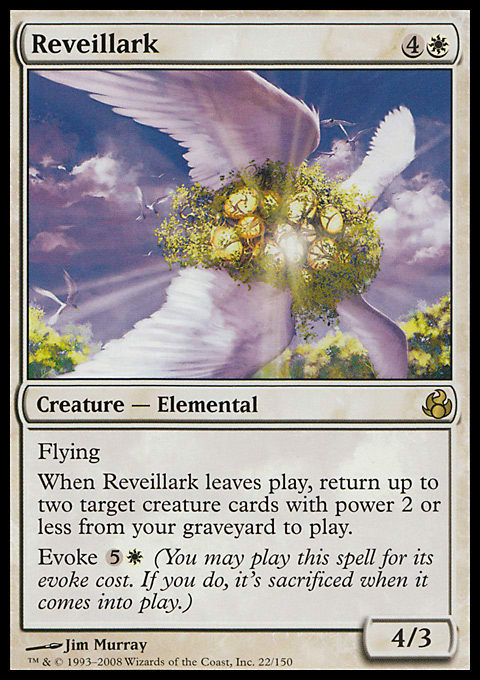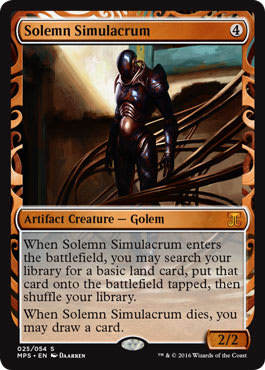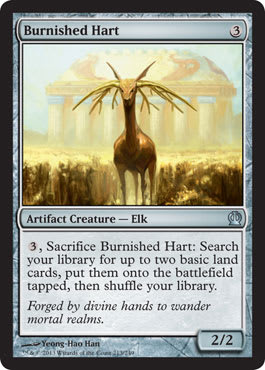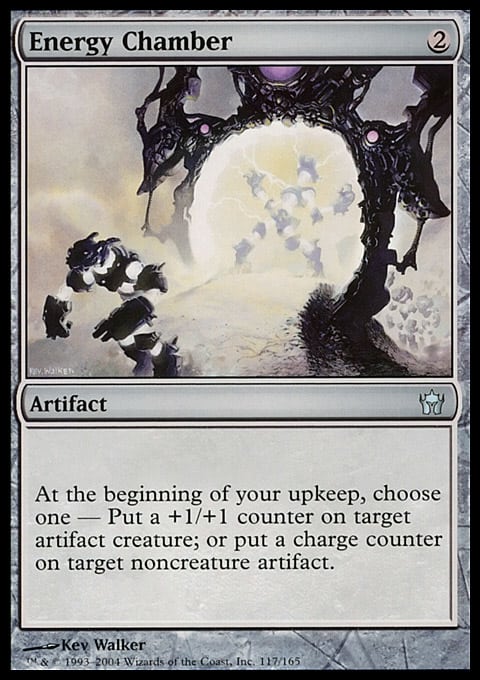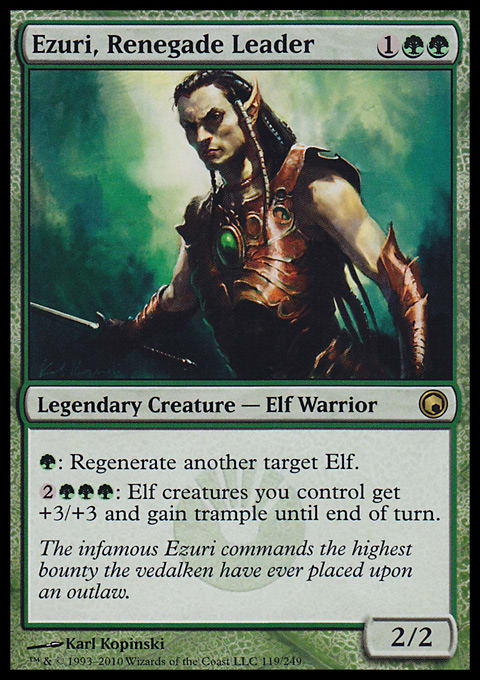In the Beginning . . .
It’s no secret that I’m a slave to value. Whether that means casting a Cultivate, recurring Sad Robot and Nezumi Graverobber with a Reveillark, or wiping the board with Decree of Pain, very few things in this game are better than getting a twofer, or even greater value, from a single card. I am a slave to value.
But being a slave to anything is bad; the truth will set us free, and the truth is that value never actually wins games. One of the secrets to winning is knowing when to aim for value and when to go for victory.
Thinning and Grinning
Thinning means building up your resource base—for example, by thinning your library through spells like Wayfarer's Bauble, Ranger's Path, and Rampalope. It can also involve proliferating counters on an Everflowing Chalice or Planeswalker, churning out Saproling tokens, or drawing cards. Building up resources is fun on its own, and it is usually a precursor to taking over games and eventually winning, but it doesn’t win games. If you find yourself losing games even though you have more lands, mana, cards, or dudes than anyone else, you're focusing on too much on thinning.
Grinning means whittling down your opponents’ resources. Removal spells and beefy critters that crush opposing forces under their furry paws/cruel talons/demonic heels are grinners. A well-timed O-Stone, Damnation, or Slum Reaper can make you grin from ear to ear—but they don’t win games. My biggest weakness as a deck-builder is that grinning is where I live—most of my decks are focused on grinning rather than on outright winning, and my favorite cards have tended to be grinners. Unfortunately, the rest of my playgroup has realized this and focused more of their decks on winning, so I am losing a lot more games than I used to. If that sounds familiar to you, you're focusing too much on grinning.
Consider you’re playing a Commander game against a Bruna, Light of Alabaster or Gisela, Blade of Goldnight deck. You’ve been dominating the game from the first turn, you’re ahead on board position, and you have a Damnation in hand just in case that pesky Angel hits the board again. But your opponent top-decks Lightning Greaves, plays and equips his or her commander, and swings for lethal damage. What happened? You were grinning, but that player was winning. And no matter what you had done before that last, decisive attack, your opponent dealt the only point of damage that mattered: the last point.
Winning
Building up your resources and controlling your opponents’ resources are both fundamental parts of multiplayer, but they are instrumental. In other words, they are not the goal, they are only a means to achieving it. Whoever dies with the most toys still dies. Ultimately, you need to be capable of—and willing to—deal the last point of damage faster than your opponents can. Let’s look at three aspects of this: deck-building, play style, and metagame.
Winning begins with your deck-building, and this is especially important for the Casual Tribe—our decks aren't forged in the competitive fires of Mt. Doom the way tournament decks are. Most casual decks begin with a cool interaction and go from there. But a lot of these interactions are about thinning or grinning rather than actually winning. Here’s an old sixty-card deck of mine that illustrates this point:
"R/G Synergy"
- Lands (23)
- 12 Mountain
- 8 Forest
- 3 Rootbound Crag
- Sorceries (26)
- 4 Flame Jab
- 4 Volcanic Hammer
- 3 Pyroclasm
- 3 Flame Slash
- 4 Explore
- 4 Harmonize
- 4 Savage Conception
- Creatures (12)
- 4 Kiln Fiend
- 4 Magnivore
- 3 Galvanoth
- 1 Fire Servant
- Others (6)
- 4 Pyromancer Ascension
- 2 Crystal Ball
As you can see, the deck is designed to put two counters on a Pyromancer Ascension and then milk as much value from that as possible. But as much fun as that is, most of my wins came from a different card: Magnivore. Drawing three cards from a single Explore is all kinds of fun, but at the end of the day, you need to smash your opponents in their faces with a 12/12 hasty Lhurgoyf if you want to win.
Here’s another example from a deck that started as the Tezzeret half of the Tezzeret vs. Elspeth Duel Decks:
"Tezzeret Evolution"
- Lands (22)
- 17 Island
- 2 Seat of the Synod
- 2 Halimar Depths
- 1 Tolarian Academy
- Artifacts (27)
- 4 Everflowing Chalice
- 4 Energy Chamber
- 3 Brittle Effigy
- 2 Tumble Magnet
- 1 Contagion Clasp
- 1 Contagion Engine
- 1 Lux Cannon
- 4 Darksteel Juggernaut
- 2 Steel Overseer
- 1 Master of Etherium
- 1 Triskelion
- 2 Triskelavus
- 1 Myr Enforcer
- Nonartifacts (11)
- 4 Thoughtcast
- 4 Trinket Mage
- 3 Steady Progress
I can't explain the fascination I have with using Energy Chamber to put charge counters on an Everflowing Chalice, but that was the main goal of this deck. Is it fun? You betcha! Does it win? Not even a little bit. And because it’s mono-blue, there aren't a ton of options for winning just through accumulating mana. So I had a deck based on thinning (building up mana), but despite the fact that this is one of my best-designed decks in terms of consistency and synergy, it rarely wins because it isn't actually designed to win.
Both of those examples show you a deck that starts with a focus on thinning and grinning, and in fact, many of my decks are like that (including my beloved Venser deck). Not surprisingly, decks that are designed to do something other than win often don’t win. On the other hand, some decks begin with a win con, such as my Avenger of Zendikar deck, and they tend to win much more easily, even if they aren't as well built.
So if your decks usually do something cute but rarely go the distance, shift more of the focus toward winning. You might even want to make a more drastic change: Start by thinking about how you want to win the game, and work backward from there—instead of concentrating on cute, but ultimately ineffective, interactions.1
Another important element of winning is including a few knockout spells in your deck, just in case you find yourself in a do-or-die situation. I can't tell you how often my Teneb, the Harvester deck had been dominating a game when someone top-decked a one-shot kill or completed a combo that took me out of the game. Sometimes, you need to be able to put an opponent away quickly, before he or she turns the tables on you.
In Commander, finding the right knockout punch can be a little more difficult—between deck size, color identity, and the Highlander format—but here are some general guidelines. Don’t build a token deck without some kind of Overrun effect or a way to translate dudes into damage (Goblin Bombardment for instance). Put a pump spell into your weenie decks (Hatred works nicely in my Mirri the Cursed deck, and there are Howl from Beyond variants in both red and green). Control decks can make use of one-shot classics Insurrection or Reins of Power. Critter-heavy decks that struggle with removal might benefit from Sudden Disappearance, Sleep, or even a Word of Binding. And red decks always need more burn.
A good way to think about the shift from thinning or grinning to winning is this: How can you take advantage of your resources or your opponents’ lack of resources? For a long time, green was considered the weakest color in Magic, but especially recently, it appears that green may be the strongest color in multiplayer, and I think this is because Wizards has made more cards that take powerful advantage of green’s mana-ramping (thinning) ability. Cards such as Genesis Wave, Omnath, Locus of Mana, Ezuri, Renegade Leader, and a ton of stupidly-large creatures (Polukranos, World Eater is my current favorite) headline modern green decks, and these cards tend to be very good at focusing the potential of a large mana base directly at your opponent’s face. Make sure your deck provides a clear path from thinning (or grinning) to winning.
Once you’ve built a deck that’s capable of winning, you need to know when to stop grinning and start winning. There is a subtle art to timing: knowing when you need to build up more (or whittle your opponents down further) and when you need to go for the throat. Do you need more mana, cards, or dudes before you can go all the way? Do you have to avoid the attention of a stronger player? Is there enough time before someone else assembles his or her doomsday device? If so, continue thinning and grinning. This is the Tao of Bruce.
If not—if you have everything you need, if there’s nobody stronger, if you’re on a clock—you need to shoot to kill. Attack the biggest threat to your strategy now, and don’t stop till that player I sdead. Then rinse and repeat. This is the Tao of Alongi.
Winning without Sinning
Finally, here’s a note on the metagame. It is generally not considered casual-cool to combo off before your opponents have had a chance to do their things—or to pick on one player and kill him or her before anyone else has taken any damage. If you think your playgroup would be disappointed if you won now, you can just sit back, take your time, and enjoy the show. However, I've noticed a significant shift in my metagame toward decks that win out of nowhere—or at least win more quickly than most decks can react. If you have experienced this, too, you need to pay more attention to winning sooner than you did in the past. And because of the power creep that Wizards has permitted over the last couple of years, I suspect you will all be dealing with this issue soon if you haven't already.
The End of the Inning
Value is fun—thinning your deck, building up your forces, and blowing up your opponents’ stuff are all fun, and they are also important parts of the game. But they aren't sufficient to win games. Casual players need to be aware of the difference between thinning, grinning, and winning; we need to build decks that are good at all three aspects of the game, and we need to know when the time has come to shift gears from value to victory.
1 The usual disclaimer applies: If you love doing cute, fun stuff but have no interest in winning games, then by all means—continue doing that. But in my experience, you can win more and have at least as much fun if you put a little more planning into your decks and gameplay, so why not give it a try? If you don’t like it, you can always go back to losing.














